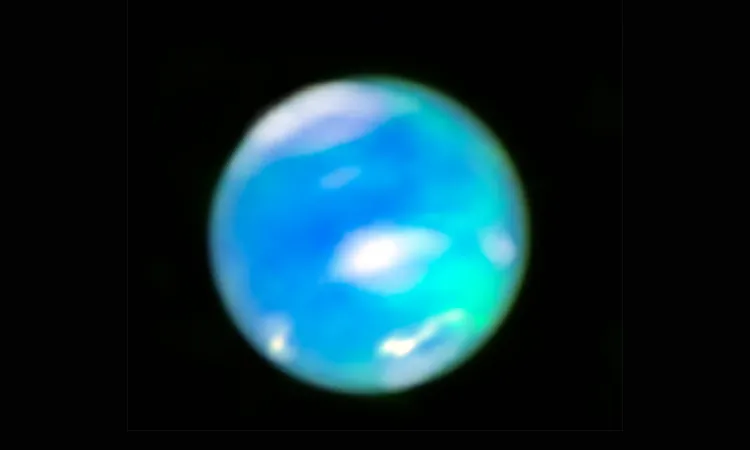
Stunning Auroras on Neptune Confirmed: James Webb Telescope Reveals Cosmic Wonders!
2025-03-30
Author: Jia
Stunning Auroras on Neptune Confirmed: James Webb Telescope Reveals Cosmic Wonders!
In an unprecedented breakthrough, astronomers have captured jaw-dropping images of auroras on Neptune for the first time, thanks to NASA's cutting-edge James Webb Space Telescope (JWST). This groundbreaking discovery brings to light the vibrant auroral activity that illuminates the gas giant’s upper atmosphere, confirming what had long been a topic of speculation among scientists.
These stunning visuals show energetic particles barreling into Neptune's ionosphere, resulting in a brilliant display of light. These particles, primarily sourced from the Sun, traverse magnetic fields before impacting the planet's atmosphere, prompting the intense emissions now captured in the JWST’s near-infrared imagery.
Though auroras have been previously documented on gas giants like Jupiter, Saturn, and Uranus, Neptune's atmospheric lights eluded detection until now. The last attempt to capture these phenomena occurred during NASA’s Voyager 2 flyby in 1989, which suggested the presence of auroras but lacked concrete evidence.
Henrik Melin, the lead author of the study from Northumbria University, shared his excitement: "Actually imaging the auroral activity on Neptune was only possible with Webb’s near-infrared sensitivity. It was astonishing to see the detail and clarity of the signature; it truly shocked me."
The observations, made in June 2023 using the Near-Infrared Spectrograph, not only captured stunning images but also gathered crucial spectral data that allows scientists to analyze Neptune's atmospheric composition and temperature. For the first time, they distinctly identified the presence of H3+, a molecule that forms during auroral activity, highlighting small cyan-colored patches in Webb's images.
H3+ is a critical indicator of auroras in gas giants, and while it has been previously used to track auroras on Jupiter, Saturn, and Uranus, Neptune had remained a mystery. Heidi Hammel, a Webb interdisciplinary scientist at the Association of Universities for Research in Astronomy, explained, "H3+ has served as a clear signifier of auroral activity on all gas giants, and we suspected the same for Neptune. Only with a machine like Webb have we finally confirmed it."
Interestingly, unlike Earth, where auroras typically occur near the poles, Neptune’s auroras appear at mid-latitudes. This anomaly is a result of Neptune's magnetic field being tilted 47 degrees relative to its rotation axis, causing the auroras to form in unexpected regions, potentially above places like South America if viewed from Earth.
The Webb Telescope's findings also reveal that Neptune's upper atmosphere has cooled significantly since 1989, with temperatures dropping by several hundred degrees. This cooling phenomenon explains the difficulty in detecting the planet's auroras in previous decades, as decreased brightness can render such displays nearly invisible.
As we venture into a new era of ice giant exploration, scientists plan to monitor Neptune over a full solar cycle—approximately 11 years. Understanding how solar activity impacts Neptune’s atmospheric behavior could unveil further insights into the dynamics of this distant planet and its magnetic field.
Leigh Fletcher from Leicester University, a co-author of the research, emphasized the importance of future missions, stating, "This observatory has finally opened the window onto this last, previously hidden ionosphere of the giant planets."
The remarkable data obtained from the Webb Telescope offers fresh perspectives on our solar system's outer worlds and has been published in *Nature Astronomy*. As we look forward to unveiling more cosmic secrets, these new findings mark just the beginning of Neptune's exploration—stay tuned for more mind-blowing discoveries!




 Brasil (PT)
Brasil (PT)
 Canada (EN)
Canada (EN)
 Chile (ES)
Chile (ES)
 Česko (CS)
Česko (CS)
 대한민국 (KO)
대한민국 (KO)
 España (ES)
España (ES)
 France (FR)
France (FR)
 Hong Kong (EN)
Hong Kong (EN)
 Italia (IT)
Italia (IT)
 日本 (JA)
日本 (JA)
 Magyarország (HU)
Magyarország (HU)
 Norge (NO)
Norge (NO)
 Polska (PL)
Polska (PL)
 Schweiz (DE)
Schweiz (DE)
 Singapore (EN)
Singapore (EN)
 Sverige (SV)
Sverige (SV)
 Suomi (FI)
Suomi (FI)
 Türkiye (TR)
Türkiye (TR)
 الإمارات العربية المتحدة (AR)
الإمارات العربية المتحدة (AR)